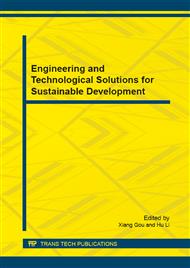[1]
X.H. Yang, On the scheme of heat transfer in waste heat recovery of flue gas, Energy and Energy Conservation. 4 (2014) 65-66.
Google Scholar
[2]
K. Chen, J.F. Wang, Thermodynamic analysis of a low-temperature waste heat recovery system based on the concept of solar chimney, Energy Convers Manage. 80 (2014) 78-86.
DOI: 10.1016/j.enconman.2014.01.007
Google Scholar
[3]
T.C. Hung, T.C. Shai, S.K. Wang, A review of organic Rankine cycles (ORCs) for the recovery of low-grade waste heat, Energy. 22 (1997) 661-667.
DOI: 10.1016/s0360-5442(96)00165-x
Google Scholar
[4]
Y.P. Dai, J.F. Wang, Parametric optimization and comparative study of organic Rankine cycle (ORC) for low grade waste heat recovery, Energy Convers Manage. 50 (2009) 576-582.
DOI: 10.1016/j.enconman.2008.10.018
Google Scholar
[5]
T.C. Hung, S.K. Wang, A study of organic working fluids on system efficiency of an ORC using low-grade energy sources, Energy. 35 (2010) 1403-1413.
DOI: 10.1016/j.energy.2009.11.025
Google Scholar
[6]
E.H. Wang, H.G. Zhang, Study of working fluid selection of organic Rankine cycle (ORC) for engine waste heat recovery, Energy. 36 (2011) 3406-3418.
DOI: 10.1016/j.energy.2011.03.041
Google Scholar
[7]
C.W. Chan, J. Ling-Chin, A review of chemical heat pumps, thermodynamic cycles and thermal energy storage technologies for low grade heat utilisation, Appl. Therm. Eng. 50 (2013) 1257-1273.
DOI: 10.1016/j.applthermaleng.2012.06.041
Google Scholar
[8]
M. Zeng, L.X. Du, Investigation on pressure drop and heat transfer performances of plate-fin iron air preheater unit with experimental and Genetic Algorithm methods, Appl Energ. 92 (2012) 725-732.
DOI: 10.1016/j.apenergy.2011.08.008
Google Scholar
[9]
B. Drobnic, J. Oman, A numerical model for the analyses of heat transfer and leakages in a rotary air preheater, Int. J. Heat Mass Transf. 49 (2006) 5001-5009.
DOI: 10.1016/j.ijheatmasstransfer.2006.05.027
Google Scholar
[10]
T. Skiepko, R.K. Shah, A comparison of rotary regenerator theory and experimental results for an air preheater for a thermal power plant, Exp. Therm. Fluid Sci. 28 (2004) 257-264.
DOI: 10.1016/s0894-1777(03)00048-7
Google Scholar
[11]
N. Ghodsipour, M. Sadrameli, Experimental and sensitivity analysis of a rotary air preheater for the flue gas heat recovery, Appl. Therm. Eng. 23 (2003) 571-580.
DOI: 10.1016/s1359-4311(02)00226-0
Google Scholar
[12]
G.C. Liu, Z.F. Wang, C.H. Deng, Numerical simulation research on mixing process of steam and crude oil, Energy Education Science and Technology Part A: Energy Science and Research. 32 (2014) 3125-3134.
Google Scholar


